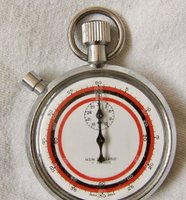This is a simple, sixty second, vintage, mechanical stopwatch. One full revolution of the sweep hand is 60 seconds. However, I am totally confused trying to understand the relationship of the 4 different registers indices. The outer register's index is simply sixty seconds. But, the outer "red" register has the numeral 20 (and so on) at the ten second 'tick'. The "black" register below it has the numeral 20 at the 12 second 'tick'. The "white" register has the numeral 20 at the 15 second 'tick'. And, the lower "red" register corresponds to the outer 60 second index..
I understand the basic, straightforward, time, speed & distance calculation of the "60 Second" register. I first though that the other three registers were designed to "read" the time, speed & distance in something other than units per hour. Perhaps kilometers per hour, nautical miles per hour, or whatever??? However, even my almost nonexistent math skills tell me there is no relationship to any of those. Nor, to the speed of sound as in perhaps the stopwatch actually being a telemeter to measure "flash / bang" distances.
Can anyone explain the registers relationships? And, or, why the dial would be configured this way? And, or, how and or, for what specific purpose it may have been designed to time? Any responses will be genuinely appreciated. (I'd even be grateful for any SWAGs but I know that is an anathema to mathematicians.)

I understand the basic, straightforward, time, speed & distance calculation of the "60 Second" register. I first though that the other three registers were designed to "read" the time, speed & distance in something other than units per hour. Perhaps kilometers per hour, nautical miles per hour, or whatever??? However, even my almost nonexistent math skills tell me there is no relationship to any of those. Nor, to the speed of sound as in perhaps the stopwatch actually being a telemeter to measure "flash / bang" distances.
Can anyone explain the registers relationships? And, or, why the dial would be configured this way? And, or, how and or, for what specific purpose it may have been designed to time? Any responses will be genuinely appreciated. (I'd even be grateful for any SWAGs but I know that is an anathema to mathematicians.)

Last edited:
